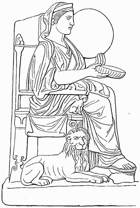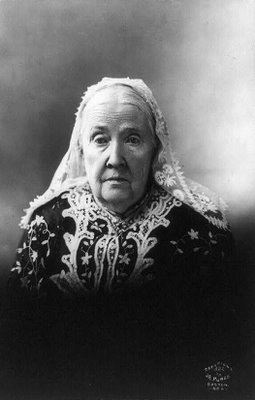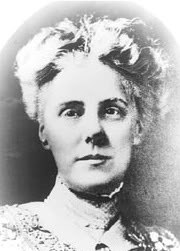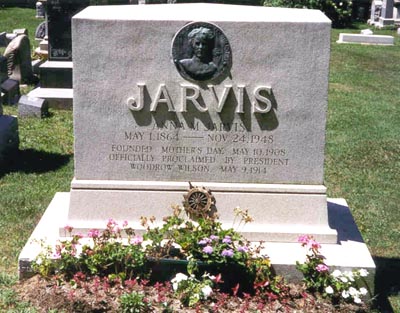Spiritual Origins of Mother?s Day
The traditional practice of honoring of Motherhood is rooted in antiquity. Ancient rites had strong symbolic and spiritual overtones, as societies tended to celebrate Goddesses and symbols of motherhood, rather than actual Mothers. Objects of adoration ranged from mythological female deities, to the Christian Church.
The personal, family orientation of Mothers Day is a relatively new phenomenon. Only in the past few centuries did celebrations of Motherhood develop a decidedly human focus, and only in last century did Mothers Day take on commercial overtones.
Goddess Isis ? Early Egyptian Roots
 One of the earliest historical records of a society celebrating a Mother deity can be found among the ancient Egyptians, who held an annual festival to honor?the goddess Isis. Her stern, yet handsome head is typically crowned by a pair of bull horns enclosing a fiery sun orb. She is most often depicted sitting on a throne.
One of the earliest historical records of a society celebrating a Mother deity can be found among the ancient Egyptians, who held an annual festival to honor?the goddess Isis. Her stern, yet handsome head is typically crowned by a pair of bull horns enclosing a fiery sun orb. She is most often depicted sitting on a throne.
As the story goes, after Isis? brother-husband Osiris was slain and dismembered in 13 pieces by their jealous brother Seth, Isis re-assembled Osiris? body and used it to impregnate herself. She then gave birth to Horus, who she hid among the reeds lest he be slaughtered by Seth. Horus grew up and defeated Seth, and then became the first ruler of a unified Egypt. Thus Isis earned her stature as the?Mother of the pharaohs.
Isis also held a place at the Roman temple, despite being aforeign?deity. The Festival of Isis was used by the Romans to commemorate an important battle and mark the beginning of winter. The celebration, which lasted for three days, centered around mostly-female dancers, musicians and singers.
It is interesting to note that the Mother and Son imagery of Isis and Horus ? in which Isis cradles and suckles her son ? is strikingly similar to that of the Virgin Mary and baby Jesus.
Cybele and Rhea ? Ancient Mother Goddesses
 Isis may have been early on the scene in Rome, but it was the emergence of two other mother goddesses, Cybele from Phrygia in ancient Anatolia (modern Turkey), and Rhea from Greece, that perhaps laid the most important foundation for the worship and celebration of motherhood in Europe.
Isis may have been early on the scene in Rome, but it was the emergence of two other mother goddesses, Cybele from Phrygia in ancient Anatolia (modern Turkey), and Rhea from Greece, that perhaps laid the most important foundation for the worship and celebration of motherhood in Europe.
The Phrygian goddess?Cybele?has roots dating back 6,000 years to Neolithic times. Phrygians celebrated a ?Mother Goddess,? whose realm was the earth?s mountains and caverns, natural surroundings, and wild animals. References to Cybele as ?Potnia Theron? (a term used by Homer to describe female divinities associated with animals) confirm to her ancient Neolithic roots as ?Mother of the Animals.?

By around 600 BC, worship of the Phrygian Mother Goddess had been adopted into much of Asia Minor, and parts of Greece.
The Greeks named her ?Cybele? and also called her ?Matar? for ?mother.?
At the same time, some Greeks already worshiped another mother goddess:?Rhea, the Greek mother of the Gods. Rhea was born from the union of the Greek goddess Gaia, the personification of Earth, and Uranus, the sky god.
The two mother goddesses Cybele (above) and Rhea (left) were so similar in their nature and iconography that they became closely, almost interchangeably, intertwined in Greek life and culture.
Magna Mater and Rome
After a meteor shower and failed harvest seemed to predict doom for the Roman republic, Rome officially adapted Cybele as its own Mother Goddess. Eventually, the Romans and the Greeks simply referred to her as Magna Mater, the Great Mother.
The Roman festival of Megalesia, to celebrate the Magna Mater goddess, was held from April 4-10, in close proximity to:
-? the Vernal Equinox (March 20/21), and,
-? the Roman festivals of Hilaria (March 15-28), in celebration of Cybele.
During the Hilaria, games were held in honor of the Mother of the Gods. Customary during the Hilaria was a procession through the streets with a statue of the goddess carried at the head, followed by a display of elaborate arts and crafts.
Early Festivals
Earlier festivals celebrating the Anatolian Mother Goddess were said to be at times so wild that they were eventually discouraged or banned. But the more conservative celebrations of Magna Mater, Hilaria and equivalents, involved eating honey cakes and sharing flowers.
European Celebration
By the 16th Century, as Ancient Roman religious and cultural traditions in Europe and England gave way to the spread of Christianity, Hilaria celebrations became part of Laetare Sunday ? the fourth Sunday of Lent in the Christian liturgical calendar (the 40 days of fasting preceding Easter Sunday). Early Christians in England initially used the day to honor the Virgin Mary, Mother of Christ ? and the church in which they were baptized, which they knew as their ?Mother Church.? This place of worship would be decorated with jewels, flowers and other offerings.
Individual Mothers Recognized

In the 17th Century, a clerical decree in England broadened the celebration from one focused on the church and the Virgin Mary, to include real Mothers, referring to the occasion as Mothering Day.
Mothering Day became an especially compassionate holiday toward the working classes of England. During this Lenten Sunday, servants and trade workers were allowed to travel back to their towns of origin to visit their families.
Mothering Day also provided a reprieve from the fasting and penance of Lent. Families across England enjoyed a family feast; Mothers were presented with cakes and flowers; and beloved, distant children came home to visit.
Read more about the?Origins and History of Mothering Sunday in the UK.
History of American Celebration
When the first English settlers came to America, they discontinued the tradition of Mothering Day. While the British holiday would live on, the American Mother?s Day would be invented ? with an entirely new history ? centuries later. One explanation for the settlers? discontinuation of Mothering Day was that they just didn?t have time; they lived under harsh conditions and were forced to work long hours in order to survive. Another possibility, however, is that Mothering Day conflicted with their Puritan ideals. Fleeing England to practice a more conservative Christianity without being persecuted, the pilgrims ignored the more secular holidays, focusing instead on a no-frills devotion to God. For example, even holidays such as Christmas and Easter were more somber occasions for the pilgrims, usually taking place in a Church that was stripped of all extraneous ornamentation.
Julia Ward Howe?s Mother?s Day Proclamation of 1870
The first North American Mother?s Day was conceptualized with?Julia Ward Howe?sMother?s Day Proclamation in 1870.

Despite having penned The Battle Hymn of the Republic twelve years earlier, Howe had become so distraught by the death and carnage of the Civil War that she called on Mother?s to come together and protest what she saw as the futility of their Sons killing the Sons of other Mothers.
With the following, she called for an international Mother?s Day celebrating peace and motherhood:
Arise, then, women of this day!
Arise all women who have hearts,
Whether your baptism be that of water or of tears
Say firmly:
?
?We will not have great questions decided by irrelevant agencies,
Our husbands shall not come to us reeking of carnage,
For caresses and applause.
Our sons shall not be taken from us to unlearn
All that we have been able to teach them of?
charity, mercy and patience.
?
?We women of one country
Will be too tender of those of another country
To allow our sons to be trained to injure theirs.?
??
From the bosom of the devastated earth a voice goes up with?
Our own. It says, ?Disarm, Disarm!?
The sword of murder is not the balance of justice!
Blood does not wipe out dishonor
Nor violence indicate possession.
As men have of ten forsaken the plow and the anvil at the summons of war.
?
Let women now leave all that may be left of home
For a great and earnest day of counsel.
?
Let them meet first, as women, to bewail and commemorate the dead.
?
Let them then solemnly take counsel with each other as to the means
Whereby the great human family can live in peace,
Each bearing after his own time the sacred impress, not of Caesar,
But of God.
?
In the name of womanhood and humanity, I earnestly ask
That a general congress of women without limit of nationality
May be appointed and held at some place deemed most convenient
And at the earliest period consistent with its objects
To promote the alliance of the different nationalities,
The amicable settlement of international questions.
The great and general interests of peace.
The Rise & Fall of Howe?s Mother?s Day
At one point Howe even proposed converting July 4th into Mother?s Day, in order to dedicate the nation?s anniversary to peace. Eventually, however, June 2nd was designated for the celebration.
In 1873 women?s groups in 18 North American cities observed this new Mother?s holiday. Howe initially funded many of these celebrations, but most of them died out once she stopped footing the bill. The city of Boston, however, would continue celebrating Howe?s holiday for 10 more years.
Despite the decided failure of her holiday, Howe had nevertheless planted the seed that would blossom into what we know as Mother?s Day today. A West Virginia women?s group led by Anna Reeves Jarvis began to celebrate an adaptation of Howe?s holiday. In order to re-unite families and neighbors that had been divided between the Union and Confederate sides of the Civil War, the group held a Mother?s Friendship Day.
Anna M. Jarvis?s Mother?s Day in 1908

After Anna Reeves Jarvis died, her daughter Anna M. Jarvis campaigned for the creation of an official Mother?s Day in remembrance of her mother and in honor of peace.
In 1908, Anna petitioned the superintendent of the church where her Mother had spent over 20 years teaching Sunday School. Her request was honored, and on May 10, 1908, the first official Mother?s Day celebration took place at Andrew?s Methodist Church in Grafton, West Virginia and a church in Philadelphia, Pennsylvania. The West Virginia event drew a congregation of 407 and Anna Jarvis arranged for white carnations ? her Mother?s favorite flower ? to adorn the patrons. Two carnations were given to every Mother in attendance.
Today, white carnations are used to honor deceased Mothers, while pink or red carnations pay tribute to Mothers who are still alive.
Andrew?s Methodist Church was incorporated into the?International Mother?s Day Shrine?in the late 1960?s, and in 1992, became a?National Historic Landmark?for its significance in the establishment of a national Mother?s Day celebration.
US Government Adoption
In 1908 a U.S. Senator from Nebraska, Elmer Burkett, proposed making Mother?s Day a national holiday at the request of the Young Men?s Christian Association (YMCA). The proposal was defeated, but by 1909 forty-six states were holding Mother?s Day services as well as parts of Canada and Mexico.
Anna Jarvis quit working and devoted herself full time to the creation of Mother?s Day, endlessly petitioning state governments, business leaders, women groups, churches and other institutions and organizations. She finally convinced the World?s Sunday School Association to back her, a key influence over state legislators and congress. In 1912 West Virginia became the first state to officially recognize Mother?s Day, and in 1914 Woodrow Wilson signed it into national observance, declaring the second Sunday in May as Mother?s Day.
The Fight Over Commercialization
The holiday flourished in the United States. Flowers, especially white carnations, became a very popular part of the celebration. One business journal, Florists Review, went so far as to print, ?This was a holiday that could be exploited.? But the budding commercialization of Mother?s Day greatly disturbed Jarvis, who vociferously opposed what she perceived as a misuse of the holiday.
In 1923 Jarvis sued to stop a Mother?s Day event. In the 1930?s she was arrested for disturbing the peace at the American War Mothers group: She was protesting their sale of flowers. Jarvis also petitioned against a postage stamp featuring her Mother with a vase of white carnations and the word ?Mother?s Day.? Jarvis was able to have the words ?Mother?s Day? removed ? but the flowers remained.
In 1938,?Time Magazine?ran an article about Jarvis?s fight to copyright?Mother?s Day, but by then it was already too late to change the commercial trend.

In opposition to the flower industry?s exploitation of the holiday, Jarvis wrote, ?What will you do to route charlatans, bandits, pirates, racketeers, kidnappers and other termites that would undermine with their greed one of the finest, noblest and truest movements and celebrations?? Despite her efforts, flower sales on Mother?s Day continued to grow. Florist?s Review wrote, ?Miss Jarvis was completely squelched.?
Anna Jarvis died in 1948, blind, poor and childless. Jarvis would never know that it was, ironically, The Florist?s Exchange that had anonymously paid for her care.
Modern Celebration
When the United States congress approved Mother?s Day in 1914, they designated it for the second Sunday in May, and required that the President proclaim the Holiday every year shortly prior to its commencement. A recent example of a presidential Mother?s Day proclamation?can be seen here.
 Typically, a family in the U.S. will devote most or all of Mother?s Day to?activities in honor of Mom, whether?playing games,?going out to dinner,taking the weekend off?or going on a walk in the park.
Typically, a family in the U.S. will devote most or all of Mother?s Day to?activities in honor of Mom, whether?playing games,?going out to dinner,taking the weekend off?or going on a walk in the park.
It is common to give Mom a?card?on Mother?s Day.Flowers?are also popular, dating back to the original celebration where Anna Jarvis handed out carnations to the church-goers.
Younger children frequently give Mom ahomemade craft?gift; older children and aduluts typically give Mom a purchased?gift?for Mother?s Day.
Indeed, within the United States, Mother?s Day continues to be highly commercialized:
- The National Retail Foundation estimates that?Mother?s Day is a $16 Billion industry.
- Florists see their highest sales in May.
- US restaurants claim that it is the busiest day of the year.
- Long distance telephone calls also peak on this day.
- The US Postal Service experiences increased volume during the surrounding days.
- According to Hallmark (via About.com),?96% of American consumers take part in shopping on Mother?s Day, while retailers report it as the second highest gift giving day of the year behind Christmas.
- Consumers spent an average of $152 per person on Mom for Mother?s Day in 2012.
?

While some continue in Jarvis? tradition of decrying the exploitation of the holiday, others appreciate the widespread availability of mom-oriented gifts, weekend getaways, brunch specials and other reminders of the day.
Contemporary cultural awareness of Mother?s Day may have grown as a result of commercialism, but there?s no denying that this is an occasion most consumers now take full advantage of, as a chance to pay special tribute to Mom.
Worldwide Spread of Mother?s Day
In many countries, the U.S. version of Mother?s Day was imported with little cultural adaptation. Others, including countries whose tradition stems from the English Mothering Day, maintain traditions quite different from those of the United States. Still others have ignored or abandoned the more religious and commercial notions of Mother?s Day, choosing instead to focus on women?s issues and women?s rights by celebrating?International Women?s Day.
While the United States? version of Mother?s Day ? the version most widely exported to the rest of the world ? has secular humanist roots followed up by extensive commercialization, many countries regardless of this Western trend, continue attach more symbolic and/or religious importance to their Mother?s Day celebrations. In Spain for example, Mother?s Day takes place during the Feast of the Immaculate Conception on December 8th. In Ethiopia the holiday is tied to seasons and agriculture, and in Yugoslavia it leads up to Christmas, commemorating the Motherhood of Christ.
Here are some of the ways in which Mother?s Day has spread throughout the rest of the world:
Argentina
Though most of South America observes Mother?s Day ? D?a de la madre ? in May, Argentina celebrates on the second Sunday in October. Due to the country?s geographical station in the southern hemisphere, it could be argued that this choice of a date for the holiday more accurately coincides with the traditional springtime seasonality of the Motherhood festivities.
It is customary to honor Argentinean Mothers with dinners, poems and special gestures of attention. Children write letters in school or make cards and crafts to take home. Husbands cook and clean and look after the family, allowing the mother to relax and enjoy the day. Moms are almost certain to receive flowers, cards, candy, jewelry or an unexpected surprise.
One example of an Argentinean Mother?s Day surprise party involves young children gathering their mothers together, encircling them in a room or hallway and reading them poetry. After the reading, a door at the end of the hall is opened to let in all the children?s grandmothers who have remained in hiding up till then. Jubilation ensues.
France
Inspired by American soldiers in World War I, France celebrated other?s Day first in 1918. The Minister of the Interior created the official day in 1920, declaring December 19?La Fete de Meres, Mothers? Day. The focus then was on the re-population of France following the high rate of attrition from the Great War (aka WWI). Mothers with four or five children were awarded a bronze medal. For six or seven the mother would receive a silver medal, and eight or more offspring garnered the gold. This tradition was abandoned when a more modern version of Mother?s Day came from the Vichy government, which on May 25, 1945, instituted the National Day of Mothers. Today a common gift is a cake shaped to resemble a bouquet of flowers, along with candies, flowers, cards and perfumes.
India
A westernized version of Mother?s Day is officially observed on May 10 in India, though cities and cultural centers tend to celebrate it more than the smaller settlements. On this day mothers receive flowers, a prepared meal, cards or a phone call.
Yet apart from the modern version of Mother?s Day, Hindus have long celebrated a 10 day festival in October called Durga Puja. As the ancient Greeks honored their earth goddess, the Hindu holiday praises their divine mother, Durga. This ancient festival has evolved into one of the biggest events in India. Families spend weeks preparing food and gifts for friends and cleaning and decorating their houses for parties. Businesses and companies now capitalize and plan their own special promotions for the event, much the same way American businesses have tapped into the market potential of Mother?s Day.
Japan
The Japanese call Mother?s Day?haha no hi. In 1913, Japanese Christians were already celebrating it, based on the American practice. It grew steadily in popularity and in the 1930?s it was especially prevalent. That changed during WWII when the practice was banned along with all other western customs.
After the war, however, the tradition was taken up again to help comfort to the Mothers who had lost children in the war. By 1949, the celebration of Mother?s Day had again spread throughout the country. The Japanese began holding an art contest for children. The children would enter drawings of their Mothers, and the winning drawings would tour through Japan and other countries in an art exhibit celebrating Mothers and peace. This contest was held every four years.
Today the Japanese celebrate Mother?s Day on the second Sunday of May. A family may prepare and enjoy traditional dishes that their mothers taught them to cook. The Japanese give their Mothers flowers (especially red carnations), scarves, handkerchiefs and handbags.
Mexico
On May 10th the Mexicans celebrate the D?a de las Madres. In 1922 a journalist, Rafael Alduc?n wrote an article advocating the celebration of Mother?s Day in all of Mexico. Though the practice had already spread to parts of Mexico, Alduc?n?s article led to widespread observance of the holiday, and May 10 is the universal day of celebration in Mexico. In the morning the mother is usually treated to a song sung by her family, or a serenade by a hired band. A family breakfast or brunch is also customary. Any family trouble or enmity is laid aside and all gather to honor the matriarch.
Mexicans typically exchange flowers and chocolates. Cards are very popular, and apparently May 10 is the largest day for card sending in Mexico. Phone calls are also customary if the child cannot make it to see their mother.
United Kingdom
Like the rest of Europe, England and Ireland observed the mid-Lent holiday and honored and decorated their ?Mother Church,? the church where they were baptized. The church eventually extended the observation to honor all mothers. The English called this Mothering Sunday and, in the 1700?s they observed it by taking a break from the fasting and penitence of Lent and having a family feast. Children would make a rare journey home from their apprenticeships and jobs to spend the day with their mother and family. Mothering Sunday fell out of practice in the early 1900?s. After WWII, however, the islanders once again picked up the tradition, inspired largely by the United States. Today the UK?s Mother?s Day continues in much the same way as the old tradition, with cards and dinners in honor of Mom.
In addition, cakes and flowers ? especially violets ? are given to Mom on Mother?s Day in the United Kingdom. It is customary to serve Simnel Cake, a glazed fruitcake inspired by a folk tale about a married couple, Simon and Nell. So the story goes, this pair could not decide bake or broil a cake. So in the end they did both. Thus Simnel Cake was born.
Yugoslavia
Tied to a three day series of holidays, the Mother?s Day cycle in Yugoslavia begins with Children?s Day or ?Dechiyi Dan? three days before Christmas. The following Sunday is Mother?s Day or ?Materitse?, and the Sunday after that is Father?s Day or ?Ochichi.?
On Children?s Day the children are tied up and not released until they promise to be good. On Mother?s day the mother is bound. To earn her freedom she must give the family treats and candy. The father gets tied the next Sunday but must promise more lavish gifts, clothing or shoes, and these items are usually the family?s Christmas gifts.
The typical gifts exchanged include candy, sweets, clothing, shoes, coats ? and promises of good behavior.
Other Countries & Regions Celebrating Mother?s Day
- Asia?- Many Asian countries that celebrate Mother?s Day tend to draw heavily from the United States? tradition.
- Australia?- The Australian Mother?s Day is similar to that of the United States, in which families visit each other and dinners. In addition to flowers, cards, jewelry and chocolates, it is customary for Australians to exchange perfume and teas on Mother?s Day.
- Bahrain?- In Bahrain Mother?s Day is called?Ruz-e Madar?and it coincides with the first day of spring, observed as March 21, as are the Mother?s Day celebrations in Lebanon and the United Arab Emirates.
- Belgium?- In the Dutch-speaking parts of Belgium the day is called?Moederdag.
- Canada?- Canada was one of the first nations to pick up the US version of Mother?s Day, making it a national holiday in 1909, one year later the United States did. The customs largely reflect those of its southern neighbor, although in Canada there seems to be an added emphasis on doing chores for the Mother and cooking her supper.
- China?- While China?s Mother?s Day distinguishes itself little from the United States?, it is interesting to note that most Chinese names begin with a character signifying Mother in honor of ones maternal heritage, helping explain the cultural compatibility of such a holiday, despite it?s having been imported from the West.
- Denmark?- In Denmark dining out to lunch is a popular Mother?s Day pastime. The day is called?Mors Dag.
- Ethiopia?- Mother?s Day in Ethiopia occurs in mid-fall when the rainy season ends. Called ?Antrosht,? Ethiopians celebrate by making their way home when the weather clears for a large family meal and a three day long celebration. For the feast the children bring ingredients for a traditional hash recipe. The ingredients are divided along gender lines, with girls bringing butter, cheese, vegetables and spices while the boys bring a bull or lamb. The mother prepares the hash and hands it out to the family. After the meal a celebration takes place. The mothers and daughters ritually anoint themselves with butter on their faces and chests. They dance while the men sing songs in honor of family and heroes. This cycle of feasting and celebration lasts two or three days.
- Finland?- In Finland Mother?s Day is called?aidipayiva. In the morning the family arises and takes a walk, picking the new flowers which bloom this time of year and making a bouquet for the mother. A particular flower called the?valkovuokko?is favored. This is a small white pungent flower. Back home Mom presented with a decorated bouquet, while also being served breakfast in bed.
- Hong Kong?- Hong Kong?s holiday, called?mu quin jie, is notable for its custom to pay honor to the parent of the Mother if she is deceased.
- Italy?- The Italians celebrate?La Festa della Mamma?with a big feast and a cake made in the shape of a heart. Typically Italian schoolchildren will make something to bring home to their Mothers, and the family will take care of the chores for the day.
- Norway?- The Norwegian?Morsdag?takes place on February?s second Sunday.
- Pakistan (and Saudi Arabia)?- The May 10 celebration of Motherhood in Saudi Arabia and Pakistan is called?Yaum ul-umm. It is inspired by and modeled after the western tradition of Mother?s Day in which all mothers are honored and given gifts. Celebrations and feasts are customary.
- Saudi Arabia?- see Pakistan
- Serbia?- Also occurring two weeks before Christmas, the Serbian Mother?s Day tradition is quite similar to the Yugoslavian one. The Sunday prior to Mother?s Day is commemorated by a ritual in which parents tie up their young ones until they promise to behave themselves. Retribution comes a week later when children bind their mother until she offers them candy and other treats. But it doesn?t end on Mother?s Day. The?following?Sunday it?s the father?s turn to be tied up until he promises some pricey gifts.
- Singapore?- Singapore?s Mother?s Day places a heavy emphasis on marketing a wide variety of gifts including spa packages, vacuums, hampers, jewelry and other more traditional presents such as flowers.
- South Africa?- South Africa celebrates Mother?s Day on the first Sunday in May.
- Sweden?- Sweden?s Mother?s Day, which takes place on the last Sunday in May, has a strong charitable focus: the Swedish Red Cross sells small plastic flowers leading up to the holiday, and the proceeds raised are given to poor mothers and their children.
- Thailand?- Perhaps the most unique Asian Mother?s Day holiday takes place in Thailand. The celebration coincides with the birthday of their beloved queen, Sirikit Kitayakara, who has reigned since 1950. Her birthday, and therefore Mother?s Day, takes place on August 12.
- Turkey?- Mother?s Day in Turkey is heavily influenced by the traditions from the United States.
Sources: Mothers Day Central
?
Source: http://www.fenwaynews.org/community/may-12-2013-is-mothers-day/
fourth of july IFE Fireworks 2012 4th Of July independence day BET Awards 2012 declaration of independence 4th Of July 2012
No comments:
Post a Comment
Note: Only a member of this blog may post a comment.